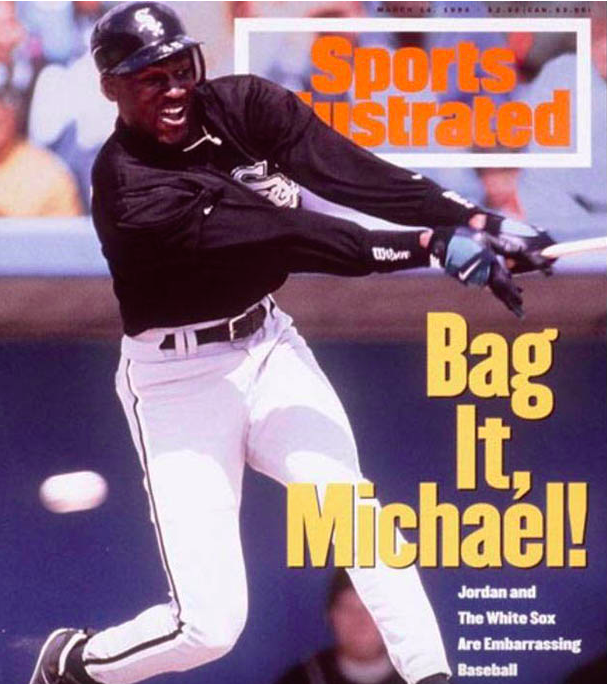

si.com
Michael Jordan’s stab at baseball did not get a glowing review from Sports Illustrated in 1994.
This past Sunday night, we reached the part in Michael Jordan’s The Last Dance in which Jordan – at age 31 and having not played baseball in 14 years – leaves the Chicago Bulls to try to make the Major Leagues.
This was 1994. As it happened, Jordan began his second professional sports “career” with the Birmingham Barons, the Chicago White Sox Class AA affiliate. The Barons included two former outstanding Mississippi college players: Chris Snopek of Ole Miss and Kerry Valrie of Southern Miss.

Rick Cleveland
I mention Snopek and Valrie here to show just how audacious it was what Jordan was trying to do. Snopek once hit .407 and with power for Ole Miss. Valrie, when he wasn’t intercepting passes to beat Alabama as a safety for the Southern Miss football team, was a speedy, line-drive hitting baseball standout.
Both Snopek and Valrie had spent several years in the minor leagues working their ways up to Class AA, which is well-recognized as the make-it-or-break-it level of professional baseball. It is often said that Class AA is where you show whether or not you can hit in the big leagues.
Jordan, after 14 baseball-less years, was trying to start there! It was ludicrous.
No doubt, Jordan was quite possibly the greatest athlete on the planet. Nevertheless, I thought what he was trying to do was unrealistic at best and foolhardy at worst and wrote just that in The Clarion-Ledger. And, on April 8, 1994, when Jordan made his Birmingham debut, I drove over to Hoover Metropolitan Stadium to see it happen. It was, as you might suspect, something akin to a circus atmosphere: standing room only crowd of more than 10,000 for a team that rarely drew even half that many. All the national news outlets were covering and so were reporters from Japan and Korea.
My first impression was that Jordan did look mighty swell in a baseball uniform – tall, strapping, broad shoulders, and slender waist.
And then he stepped into the batter’s box and did not look so good – at all. Actually, Jordan narrowly escaped calamity before he ever came to bat. The second batter for the Chattanooga Lookouts lofted what should have been a routine fly ball to right field, where Jordan was playing. Jordan misjudged it, recovered and then made a leaping catch. If you’ve ever seen a little league game, you’ve probably seen the same thing happen. No matter, from the crowd reaction, you might have thought Jordan had leaped over the moon to rob a home run.
When Jordan, batting seventh, came to the plate in the second inning, he lifted a lazy fly ball that either the second baseman or right fielder could have caught. The right fielder took it. And that was the batting highlight of the night for Jordan. He struck out on both his second and third at bats, looking like a uniformed impostor on his last at bat, flailing at a third-strike breaking pitch that he missed by a foot.
Jordan was on deck when the game ended and most of the sellout crowd was still around – a testament to just how big a draw he was.
Afterward, both Valrie and Snopek sang praises of their famous teammate.

Kerry Valrie
“People talk about his lack of bat speed,” Valrie said. “All I can say is he hits as many balls out of the park in batting practice as anyone.”
Perhaps, but that’s why they call them batting practice fast balls.

Chris Snopek
Said Snopek of Jordan, “If he were 22 or 23 now, there’s no question he would become a Major Leaguer. He has the tools. The only question is his age.”
From all accounts, Jordan was a terrific baseball teammate. He catered elaborate post-game meals and even paid to upgrade the Barons’ team bus that took them from ballpark to ballpark around the Southern League. “Everybody is pulling for him,” Valrie said. “He’s a great guy. He just wants to be one of the team like everyone else.”
But he was Michael Jordan, of course. And baseball surely made him human. When Class AA pitchers learned he could not hit a breaking pitch, that’s virtually all he was thrown. He struck out 114 times in 436 at bats. He eventually hit .202 for the season. That’s right: The greatest athlete in the world couldn’t hit his weight at Class AA.
In retrospect, we probably should remember his successes – amazing considering the circumstances. He did drive in 51 runs. He did walk 51 times. He did steal 30 bases.
You know the rest of the story. Jordan went back to basketball the next year and led the Bulls to three more NBA titles, further establishing himself as the greatest basketball player in history of the sport.
But baseball, as it does so many, humbled him.
“I’m just learning the game,” Jordan told us that night. “I’m trying to get to where these young guys are right now. My hand-eye coordination is good, but it has been trained to do something else for 14 years. It’s going to take a lot of swings, a lot of practice. I’m here to give it a shot.”
The post Let’s re-visit Michael Jordan’s version of ‘I’m coming home, they started throwing curves’ appeared first on Mississippi Today.
- AP sources: In ‘Nassar 2.0,’ Olympics watchdog failed to close abuse case against gymnastics coach - December 30, 2025
- I took the National Museum of African American History and Culture for granted. Trump’s threats changed that - December 30, 2025
- New film portrays FBI’s dance with a Mafia devil to solve KKK killing - December 30, 2025